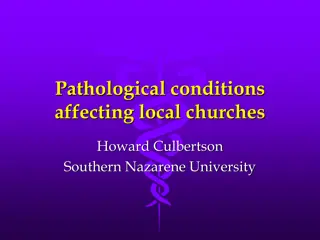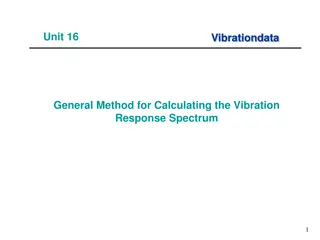Introduction to Electrical Engineering: Complete Response
Introduction to the concept of complete response in electrical engineering, covering natural response, forced response, and the addition of both components. The lecture also includes examples and step responses of RL and RLC circuits.
13 views • 65 slides
Emergency Nutrition Response in Sudan - GNC Partners Call
The GNC partners called for an emergency nutrition response in Sudan on August 23, 2023. The agenda included updates on the situation in Sudan, response strategies, operational challenges, funding gaps, and upcoming priorities. Details on the nutrition situation pre-conflict, acute malnutrition stat
6 views • 29 slides
Pathological Fractures
Pathological fractures occur in weakened bones due to underlying diseases or conditions, often manifesting with minimal trauma. Common causes include neoplastic lesions, infections, metabolic imbalances, and developmental disorders. Recognizing these fractures is crucial for timely intervention and
1 views • 20 slides
Pathology of the urinary system
Focal segmental glomerulosclerosis (FSGS) is characterized by sclerosis of some glomeruli, while membranous nephropathy (MN) involves subepithelial immunoglobulin deposits. FSGS can lead to end-stage renal disease, with poor response to corticosteroid therapy. MN, on the other hand, shows diffuse ca
1 views • 20 slides
Understanding Cellular Pathology: Response to Stress and Disease Predisposition
Explore the hallmarks of cellular pathology, including factors influencing disease predisposition such as genetics, environmental factors, and lifestyle. Delve into the cellular response to stress, adaptive and pathological reactions, and key stressors disrupting cellular homeostasis. Uncover how ce
0 views • 51 slides
Emergency Response Proposed Rule - Worker Safety and Health Conference
The Emergency Response Proposed Rule aims to update regulations for worker safety and health, expanding coverage to include technical search and rescue and emergency medical service entities. The rule proposes replacing the existing Fire Brigades standard with an Emergency Response standard. Federal
2 views • 23 slides
Comprehensive Guide to Initial Operational Response (IOR) in Hazardous Substance Incidents
This guide outlines the objectives, principles, and key elements of Initial Operational Response (IOR) to incidents involving hazardous substances or CBRN materials. It covers the stages of response, transition to Specialist Operational Response (SOR), primary objectives of IOR, JESIP principles, an
4 views • 25 slides
Online Consumer Complaint Filing and Response Process in India
Learn how to file a consumer complaint online and write a response as an opposite party in Consumer Forums of India through the Edaakhil portal. Understand the steps for registration, login, and filing a response for approved complaints and responses. Discover how to search for cases and access case
4 views • 15 slides
Rapid NHS Response Teams: Enhancing Home Care and Avoiding Hospital Admissions
Somerset Foundation Trust Community offers a comprehensive range of services, including Rapid Response, Urgent Community Response (UCR), and Hospital@Home (H@H). These services aim to provide timely and effective care to individuals in their homes, reducing the need for hospital admissions. Rapid NH
15 views • 6 slides
Enhanced Demand Response Monitoring for ERCOT Operator
ERCOT aims to enhance its demand response monitoring capabilities through the implementation of a proposed Demand Response Monitor. The monitor will enable operators to better understand real-time demand response patterns and predict future needs, ultimately improving reliability and reducing the ne
2 views • 6 slides
Enhancing ERCOT's Capacity Assessment with Demand Response Monitoring
Demand response in ERCOT has been increasing, with forecasts of continued growth. The system operator can identify MW peaks by analyzing total ERCOT load data. A proposed Demand Response Monitor would assist in predicting future capacity needs based on responses from loads like LMP energy prices and
0 views • 7 slides
Understanding Community Lifelines and Core Response Capabilities for Stabilizing Communities
The National Response Framework aims to strengthen response actions by coordinating across the entire community to stabilize community lifelines. Community lifelines are critical services essential for human health, safety, and economic security. Stabilizing these lifelines is crucial during respons
2 views • 14 slides
Understanding Fractures: Traumatic vs. Pathological and Modeling Options
Defining the distinction between traumatic and pathological fractures, exploring the relationship between non-traumatic fractures and underlying bone pathologies, and discussing modeling options for classifying fractures. Stress fractures, insufficiency fractures, and the causes of pathological frac
2 views • 8 slides
Understanding Resins: Composition, Occurrence, and Classification
Resins are solid/semisolid amorphous products with complex chemical composition and are found in plants, animals, and fossils. They contain essential oils, terpene products, and carboxylic acids. Resins occur as a result of normal metabolism or in response to injury, forming physiological or patholo
1 views • 37 slides
Theories of Reinforcement in Behavioral Economics
Explore key theories of reinforcement including Thorndike's Law of Effect, Hull's Drive Reduction Theory, the Premack Principle, Response-Deprivation Hypothesis, and Behavioral Economics concepts such as Response Allocation. Learn about reinforcers as stimuli, primary and secondary reinforcers, the
2 views • 9 slides
Understanding the Significance of Cytokines in Immune Response
Cytokines play a crucial role in immune response activation and regulation. They are secreted by various cell types like lymphocytes, monocytes, and macrophages, exerting diverse biological functions, including immune system development, inflammatory response induction, and hematopoiesis regulation.
2 views • 12 slides
Understanding Fever: Causes, Assessment, and Management in Emergency Medicine
A temporary increase in core body temperature, aka fever, can be a response to various conditions, both physiological and pathological. It is a common complaint in emergency departments, with infections being a primary cause. Assessment involves looking into associated symptoms, duration, medical hi
0 views • 14 slides
Emergency Response and Management Overview
Understanding emergency response involves defining terms like emergency, supervision, command, and coordination. This includes the objectives of emergency response operations, key characteristics, requirements for effective response, and stages of response such as warning, threat, incident, assessme
6 views • 15 slides
Understanding Pathological Pigmentation: Causes and Effects
Pathological pigmentation involves the abnormal deposition of pigments in the body. It can be classified as exogenous or endogenous, with various sources and types of pigments. Melanin, one of the endogenous pigments, plays a crucial role in determining tissue color and can have protective functions
5 views • 23 slides
Understanding Quantitative Aspects of Drug Action
Explore the quantitative aspects of drug action, including drug receptor binding, concentration binding curves, dose-response curves, and types of antagonism. Learn to relate drug concentration to receptor binding capacity and response produced. Discover how concentration binding curves and dose-res
0 views • 29 slides
National Response Center Operations Overview
Established as a vital support entity in the National Response System, the National Response Center (NRC) serves as the federal contact point for pollution incident reporting. Handling various responsibilities such as coordinating responses to pollution, railroad, and port security incidents, the NR
0 views • 11 slides
Cyber Incident Response Planning and Team Organization
This comprehensive incident response planning companion provides guidelines for creating effective policies and plans, emphasizing the importance of customization to suit each agency's unique circumstances. It outlines the purpose, objectives, and structure of an incident response plan, along with t
0 views • 16 slides
Addressing Pathological Conditions in Local Churches
Pathological conditions affecting local churches such as "Ethnic-itis," "Ghost town," and "People blindness" are discussed along with their symptoms and remedies. Solutions include transitioning to reflect the neighborhood, using circuit-riding pastors in rural churches, and celebrating cultural dif
1 views • 20 slides
Understanding Basis Functions and Hemodynamic Response Functions in fMRI Analysis
This content discusses the use of basis functions, parametric modulation, and correlated regressors in the first-level analysis of fMRI data processing. It delves into the concept of temporal basis functions for modeling complex functions of interest, such as the canonical hemodynamic response funct
1 views • 26 slides
Tips for Cambridge IGCSE Paper 2 Extended Reading Response
Develop your response effectively for Cambridge IGCSE Paper 2 Extended Reading by following these top tips: read the passage, deconstruct the question, skim for relevant ideas, determine writing style and audience, plan your response using highlighters, and focus on content and quality of writing. S
1 views • 26 slides
Guidelines on EPA Region 9 Response Action Levels for TCE Contamination
EPA Region 9 has established response action levels for TCE contamination, with tiered concentrations for different exposure scenarios. The State of California provides guidance aligned with these levels. DTSC concurs with EPA's residential and industrial response levels but recommends consultation
0 views • 10 slides
Strategies for Reaching Hard-to-Count Communities Using Low-Response Score
Explore how to leverage a low-response score to engage with hard-to-count communities effectively. Learn about ROAM mapping tool, the 2020 Census goal, and the significance of Low Response Score (LRS) in identifying areas for targeted outreach. Discover hard-to-count variables and how to utilize dat
0 views • 14 slides
Pathological Differences in Hip Joint Variations: Abnormal Gait Analysis
Understanding pathological gait variations related to hip joint differences is crucial in gait analysis. Excessive sagittal, coronal, and transverse plane motions impact stance and swing phases, leading to deviations in gait patterns. Excess flexion, limited flexion, past retraction, excess adductio
0 views • 13 slides
Impact of Number of Contact Attempts on Response Rates in Multimode Surveys
This meta-analysis investigates the effects of the number of contact attempts on response rates and web completion rates in multimode surveys. Benefits of multimode surveys include improving coverage, increasing response rates, reducing costs, and enhancing measurement accuracy by utilizing multiple
0 views • 27 slides
Clinical and Pathological Staging Cases in Oncology
This collection highlights clinical and pathological staging cases in oncology, covering scenarios from colon, lung, bladder, and kidney cancer. Each case presents detailed information on tumor characteristics, lymph node involvement, metastasis status, and clinical stages. Images accompany the desc
0 views • 9 slides
Enersponse Inc. Demand Response Programs Summary
Enersponse Inc. is a Demand Response Aggregator managing a large number of commercial, industrial, agricultural, and municipal water pumping locations in North America. They utilize a DERMs platform and various software integrations to manage customer participation efficiently. The company actively
0 views • 21 slides
Vibration Response Spectrum Analysis for SDOF Systems
This article covers the calculation of the Vibration Response Spectrum for Single-Degree-of-Freedom (SDOF) systems subjected to base excitation using a general method equation. It explains how to determine the response for a family of natural frequencies and plot the results as VRS. The content incl
0 views • 16 slides
Understanding Local RA Requirements for Demand Response Resources
Explore the factors influencing the maintenance of current requirements for demand response programs, including response times and procurement considerations. Learn about CPUC decisions emphasizing fast-responding DR resources and recent rulings on demand response auction mechanisms. Discover how lo
1 views • 10 slides
Distribution System Contamination Tabletop Exercise Overview
This tabletop exercise focuses on simulating a distribution system contamination scenario to enhance emergency response preparedness. Participants engage in various activities like reviewing materials, facilitating discussions, and action planning to improve response capabilities. The exercise aims
0 views • 35 slides
Unveiling the Mysteries of Pathological Proteins
The Pathological Protein delves into the intriguing case of Stephen Churchill, a young man whose sudden decline and tragic death spark questions about his mysterious neurological condition. As the investigation unfolds, more puzzling cases emerge, shedding light on the enigmatic world of neurodegene
0 views • 21 slides
Understanding Pathological Calcification in Veterinary Pathology
Pathological calcification is the abnormal deposition of calcium salts in soft tissues, with two forms - dystrophic and metastatic calcification. Dystrophic calcification occurs in dying tissues, while metastatic calcification reflects a derangement in calcium metabolism. Dystrophic calcification ca
0 views • 11 slides
ConnectWise Incident Response Service: Expert Help for Security Incidents
ConnectWise Incident Response Service offers expert assistance 24/7 for handling worst-case security incidents. Gain direct access to incident response analysts, real-time management, recovery procedures, insights on attacker tactics, and post-incident monitoring. Choose from flexible service option
0 views • 13 slides
Lead Compensator Design for Improved Transient Response in Automatic Control Systems
Lead compensators are utilized in automatic control systems to enhance transient response. By designing a lead compensator, one can adjust stability and error parameters for optimal system performance. This involves determining the appropriate gain and phase margin to meet error constraints and achi
0 views • 12 slides
Understanding Pathological Gambling: Diagnosis and Epidemiology
Pathological gambling, characterized by the inability to resist the urge to gamble despite severe consequences, is a progressively worsening disorder. This text discusses the diagnostic criteria for pathological gambling, its positive diagnosis according to DSM-IV-TR, and epidemiological data on the
0 views • 23 slides
Decoding the Role of Host PrP in Transmissible Spongiform Encephalopathies
Research led by the Professor and Head of Neuropathology at Yale focuses on the relationship between host PrP and TSE viruses, proposing that viral interactions with PrP trigger a pathological response. Contrary to popular belief, evidence suggests that PrP-res is a consequence of infection rather t
0 views • 28 slides







































